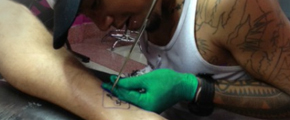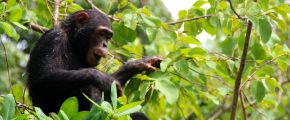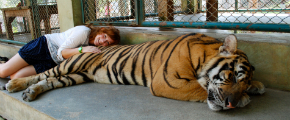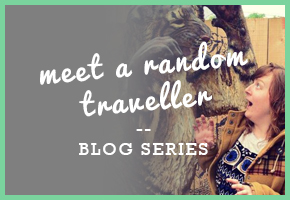You’ve read Jane Goodall’s books and now you’ve made the best decision of your life and are planning to visit Gombe National Park and experience the chimpanzees for yourself. Brilliant – but how on earth do you plan it from the other side of the world? Well, we are here to help you.
Park office in Kigoma
The easiest way to plan trips to Gombe is from within Kigoma (The closest town to GNP). The park has an official office in town and trips can be arranged as quickly as the same day depending on your transport method.
The park office isn’t in the centre of Kigoma but up a hill behind the market. From the market walk up the hill and then take the second right, this will take you behind the market and then up a steep dirt road. Keep walking up and you will find the park office on the right. It’s quite near the top of the hill so don’t think you’ve walked too far, the office is quite grand (for the area) and hard to miss.
We emailed the office before arriving in Kigoma however they didn’t reply and they seemed to be having difficulty with the internet when we were there. As mentioned above, as the trips can be arranged so quickly it’s probably just worth waiting until you are in Kigoma, the staff are very helpful (and not pushy) so you’ll also get the benefit of having a long chat about the park before deciding how you want to go about your trip.
Transport options
The only way to get to Gombe National Park is by boat! There are four different options ranging in price.
Public boat – This is your cheapest option by far – about $4. The price is obviously a big benefit but the boats can be unreliable and make a number of stops. Journey time is at least 4 hours, boats are often crowded and there is no shade available. The boat only travels once each day leaving Kigoma at around lunch time and returning from Gombe at around 7am.
Private boat – You can hire a private boat to take you to Gombe for around $220, you will have shade, a life jacket and you can decide the time it will take you to the park entrance. It takes about two hours to get from Kigoma to the park entrance, half the time of the public boat, which means if you wanted you could do the journey in a day (no accommodation fees).
Tanapa boat – The national park’s official boat is a bit more expensive than the private ones ($300) but has all the same pros.
Speed boat – This is by far the quickest way to get there taking only 45 minutes however it also costs a fortune – $1200!
We chose a private boat to take us to the park around lunch time, this way we could have two treks, one on the afternoon we arrived and one the following morning (Also meaning we only had to pay one 24 hours park fee). With limited time the flexibility of all but the public boat are a real plus, you determine all the times plus, the price is per boat so the more the merrier.
If you wish to take a private boat ask the staff at the office if they know anyone. The staff we spoke to were happy to arrange everything for us and the boat’s captain even came to meet us at the office the day before.
Accommodation
There are two options for staying the night in Gombe:
Camping – You’ll have to bring your own tent and sleeping bags and you can expect a lot of interested baboons during the night, they are a constant in camp.
Banda – Ensuite rooms with two single beds & mosquito nets. The banda is the same price as camping and an easy choice. With so many baboons in camp, we get the impression that the park would rather you chose these rooms than camping to avoid any problems with food or belongings. The banda is locked up with bars across the windows (like every other building in the park) so it’s much harder for them to come in. The rooms are comfortable and better than we expected, especially for the price.
Food
The food is relatively expensive in the restaurant ($15) however the portions are big and they will pretty much cook whatever you request. After a big trek it was nice to come back to a warm meal that we didn’t need to prepare ourselves. You can also bring your own food and prepare it in their kitchen – you have to store all food in the kitchen as once again the chimps and baboons have been known to steal it!
Drink
The drinks are much better value and there is a large variety to chose from including beer, wine, soda and juice all at very reasonable prices. Sprite 1,500TSH, Castle Lager 3,000TSH and large water 2,000TSH. You can also bring your own drinks from Kigoma.
Park entry fees
To enter Gombe National Park it is $100 per a person per 24 hours. The 24 hour permit usually starts from when you enter the forest so if you are coming by public transport and arriving at 4pm it should start the following day, when you set out on your first trek and last until the following morning. They are happy for you to stay at the beach after the 24 hours is up – but you won’t be allowed to enter the forest again.
To be clear: You do not need to pay park fees to be in camp, meaning you can enjoy the lake, rooms and restaurant either side of your 24 hour permit.
Guide fees
Every time you enter the forest you need to pay a $20 guide fee per a group (maximum 5 people). If you plan to go trekking more than once you will need to pay again however, the guide usually includes a trek to the old feeding station, waterfall and Jane’s peak in one of the treks.
Swimming
Remember to take your swimming costumes with you as the camp is right by lake Tanganyika, it was lovely taking a dip after the long hard treks in the forest.
Total spent for two people
- Boat: $230 (price for boat not pp)
- Accommodation: $40 ($20 per person, per night)
- Entry Fee: $200 (2 x $100 24 hour park fee)
- Guide Fee: $40 (2 treks)
- Food: $30 (2 x $15 evening meal)
- Drink: $5
- Tips: $17 (Paid in Shillings to trackers and guide)
- Total: $532 (£330)
We hope this helps you plan your own trip to Gombe and to get you even more excited why not read our incredible experience of the park here, it didn’t disappoint.
If you would like to know more then please just ask!






 Getting a Bamboo Tattoo in Thailand
Getting a Bamboo Tattoo in Thailand The Journey That Ruined our Honeymoon
The Journey That Ruined our Honeymoon Meeting Chimps in the Wild - Tanzania
Meeting Chimps in the Wild - Tanzania The Reality of Working a Ski Season
The Reality of Working a Ski Season Tiger Kingdom, Chiang Mai, Thailand
Tiger Kingdom, Chiang Mai, Thailand 



{ 8 comments… read them below or add one }
Hey guys, some really fab and detailed information here – thanks so much for the full lowdown and comprehensive costings. It does seem like a pretty expensive adventure, but I guess worth it for a once in a lifetime trip? We’d be tempted to camp to keep the cost down – do you know anyone who did this? did they manage to get any baboon-free shut-eye?!
Steph of Big World Small Pockets´s last blog post ..7 Off The Beaten Track Places In Queensland, Australia That You Need To Visit
A pitch to put your tent on is actually the same price as the rooms they offer in the park so there really is no reason to camp. As we mentioned I think the park actually prefers you taking the room as it keeps any potential problems to a minimum. We didn’t see or hear of anyone camping there while we were about I’m afraid.
We really can’t recommend the place enough though, we had such a fantastic time there and it didn’t disappoint at all.
Wow, beautiful photos, and it sounds super relaxing! I’ll certainly add it to my list!
Stunning pictures of wildlife and culture! Check this cool travel blog!
Travel Blogs & Images
Jenny´s last blog post ..Eungella Platypus
Good morning! Thank you so much for posting this blog. I have been searching the Internet for a solid 10 hours looking for some tips. Thank you – Tyler
Hello!
this is a really well written post, thanks! Although some time has passed I was wondering about food. Are meals available?
Asante!
There was when we were there and it was very tasty too 😀
Thank you for this information. We are interested in seeing the chimps in Hombe National Park. We are in our 70’s. Tho reasonably fit, comments we have read describe the hiking as strenuous, long and through vegetation. Is there any trekking that is easier and will still enable seniors to see the chimps? Thanks!!
Hi There!
I think the hiking can change from day to day depending on where the rangers have found the chimps, they were on the move quite a lot while we were there and I’d be lying if I said the hiking wasn’t challenging at times.
I hope you find a way to make it work and have a great trip, it was an amazing experience.
Cheers